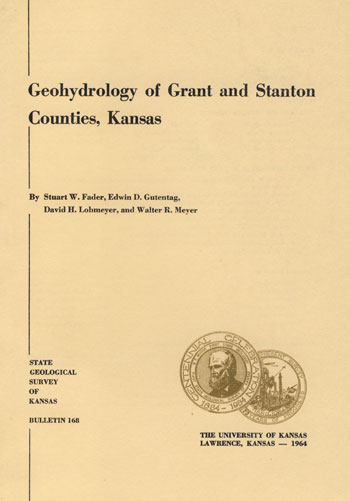Geohydrology of Grant and Stanton Counties, Kansas
by Stuart W. Fader, Edwin D. Gutentag,
David H. Lobmeyer, and Walter R. Meyer

Originally published in 1964 as Kansas Geological Survey Bulletin 168. This is, in general, the original text as published in 1964. The information has not been updated.
You may also wish to visit our web sites on the Grant and Stanton county geologic maps.
Abstract
A study of the geohydrology of Grant and Stanton counties, comprising 1,260 square miles, is contained in this report. The principal cities are Ulysses, in Grant County, and Johnson, in Stanton County. Normal annual precipitation is 17.24 inches at Ulysses and 15.03 inches at Johnson.
The rocks in the two counties range in age from Permian to Recent. Unconsolidated deposits of Neogene age (Pliocene and Pleistocene) underlie most of the area and contain aquifers that annually supply about 250,000 acre-feet of water for irrigation. The Pleistocene deposits reach a maximum thickness of 455 feet in the southeastern part of the area. The areal extent, thickness, and water yields of sandstone aquifers of Cretaceous and Triassic age are given. The coefficients of transmissibility and storage of the Pliocene and Pleistocene aquifers were determined by tests at 26 sites. The data thus obtained were used to estimate the hydrologic characteristics at localities where adequate well logs were available. The extrapolated transmissibility data were used to analyze the movement of ground water.
Approximatelv 58 mgd (million gallons per day) of ground water is flowing into Stanton County from the west, and approximately 86 mgd is flowing out of Grant County to the southeast. This difference is due to the addition of lateral flow from the adjacent counties to the north and south and from precipitation within the area. The recharge from precipitation was computed to be about 0.3 inches per year or 2 percent of the average annual precipitation. Inflow and outflow in the area were approximately the same in 1940 as in 1960. Therefore, most of the water pumped for irrigation since 1940 has been removed from storage.
Analyses of the six water-level contour maps indicates that the weighted-average water level declined 8 feet between 1939-42 and 1960 and 18 feet between 1939-42 and 1963. Prediction of future water levels based on these data was not attempted because of the close relationship of water level to the annual pumping rate, which varies considerably.
The two counties contain 55 million acre-feet of ground water in storage of which about 39 million is in the unconsolidated aquifers and 16 million in the sandstone aquifers. However, from a practical standpoint, not more than about half this amount of water can be recovered for irrigation use.
Kansas Geological Survey, Geology
Placed on web July 17, 2007; originally published December 1964.
Comments to webadmin@kgs.ku.edu
The URL for this page is http://www.kgs.ku.edu/General/Geology/Stanton/index.html